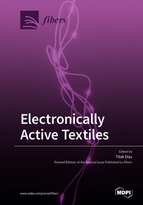Electronically Active Textiles
A special issue of Fibers (ISSN 2079-6439).
Deadline for manuscript submissions: closed (31 December 2018) | Viewed by 44642
Special Issue Editor
Interests: electronically functional yarn (E-yarn); advanced 3D knitting technology; active compression garments; fabric antennae; electronic textiles
Special Issues, Collections and Topics in MDPI journals
Special Issue Information
Dear Colleagues,
Since its invention, textile material has gone through many evolutions; initially, the focus was on enhancing aesthetic properties, such as colour, handle and comfort, of a textile, and, much later, especially during the last century, the focus has been on improving the functionality of a textile. This has led to the development of fabrics capable of stopping a bullet travelling at supersonic speeds, fire retardant fabrics and impact and cut resistant fabrics. All these functionalities have been achieved via chemical processes and advances in polymer science. Textiles are now going through a new evolution of integrating electrical systems and electronic devices.
Textiles are used to clothe our bodies because they are strong, soft, breathable, flexible and conformable. The introduction of electronic components has the potential to compromise some of these highly-desirable characteristics, however, the proper integration would result in introducing, for the first time, intelligence to textile materials.
The purpose of the Special Issue is to report the advances in the integration of electronics into textiles which has provided a platform for developing a range of new novel products in fields, such as healthcare, sports, protection, transport and communication.
Prof. Dr. Tilak Dias
Guest Editor
Manuscript Submission Information
Manuscripts should be submitted online at www.mdpi.com by registering and logging in to this website. Once you are registered, click here to go to the submission form. Manuscripts can be submitted until the deadline. All submissions that pass pre-check are peer-reviewed. Accepted papers will be published continuously in the journal (as soon as accepted) and will be listed together on the special issue website. Research articles, review articles as well as short communications are invited. For planned papers, a title and short abstract (about 100 words) can be sent to the Editorial Office for announcement on this website.
Submitted manuscripts should not have been published previously, nor be under consideration for publication elsewhere (except conference proceedings papers). All manuscripts are thoroughly refereed through a single-blind peer-review process. A guide for authors and other relevant information for submission of manuscripts is available on the Instructions for Authors page. Fibers is an international peer-reviewed open access monthly journal published by MDPI.
Please visit the Instructions for Authors page before submitting a manuscript. The Article Processing Charge (APC) for publication in this open access journal is 2000 CHF (Swiss Francs). Submitted papers should be well formatted and use good English. Authors may use MDPI's English editing service prior to publication or during author revisions.
Keywords
- e-Textiles
- electronic textiles
- advanced functional textiles
- technical textiles
- medical textiles
- fabric antennae
- light emitting textiles
- communication textiles






